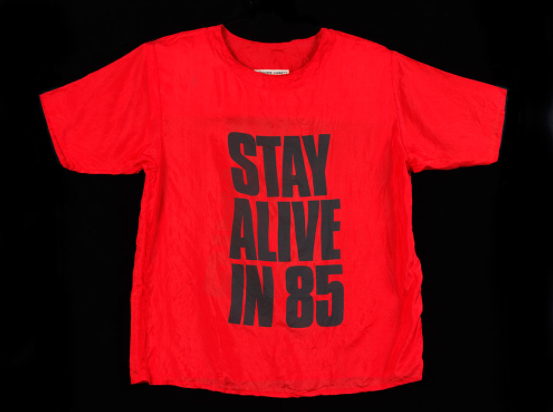Hello Stradi Girls and Boys !
During our stay in London, we went to this FABULOUS exhibit at the Victoria and Albert Museum (entry 5-7£):
CLUB TO CATWALK LONDON FASHION THE 1980'S. There were dozens of mannequins wearing those iconic items, divided by theme, and some areas with videos and music reflecting the era's atmosphere (we were dancing all along the visit).
You really have to visit CLUB TO CATWALK, it's so inspiring and lasts until February 2014.
If you can go, don't miss it !


In 86, Blitz Magazine ordered 22 young designers to custom Levi's jackets (left: Vivienne Westwood, right: Leigh Bowery). Each designers had a different approach and used different material such as gold hair grips... Vivienne Westwood said: " I was proud of my jacket. I like to take traditional things and push them into the future."
Speaking of Vivienne, she opened her first shop with Malcolm McLaren, called S.E.X. in 1974. Malcolm wanted a black shop where fetish clothes could be bought. They decorated the shop with a sponge material to make it look like an uterus. Vivienne got inspired by the shop and sharpened her inspiration to make some provocative clothes instigated by sexual taboos. With Malcolm, they started to create slogan T-shirts which will become their new style.
When we saw the wings jacket and other pieces of this collection (picture above), it made us think of Jeremy Scott and we had NO CLUE that he wasn't the first to use the wings and other details. We were so amazed that Vivienne did that years ago because when Jeremy did it, we already thought that it was so great. It proves that fashion is not only "this month's trend" but it comes from yesterday (yesterday...we mean the past !) and for us, it's really important to be interested by fashion's history to get to know where the trends come from and its meaning.
Malcolm McLaren and Vivienne Westwood


Front window of S.E.X. shop and crazy people
Katharine Hamnett (picture above) was one of the first to put meaningful quotes on T-shirts. She used clothes to send a political message, in that crisis period. A lot of music bands wore her clothes. Most of the time, T-shirts were unisex and had straight cut. She wrote, always in cap lock: "SAVE THE WORLD" "STOP AND THINK" "USE A CONDOM" etc... Nowadays, Katharine is asking herself about the concrete impact of the T-shirts and she thinks they may be a substitute for action.
Zandra Rhodes
Inspired by the Punks' style (safety pins, chains, shredded clothes), Zandra Rhodes presented the first collection of this kind in 1977. During the new wave era, she was one of the designers who put London fashion under the spotlight. She's known for her use of bright colors, dramatic and bold take on design.

High Camp lovers at Taboo Club
Taboo Club (along with the Blitz Club and others) was a land-mark of the nightlife in London where people from every tribes met to party without limits and boundaries. The club was named this way to make people want to break all the taboos and to be opened to everything.
John Galliano said that during his studies at Central St-Martins, there were no students on Thursday and Friday because they were all at home, hangover, but mostly busy designing and sewing brand new clothes to put on for the night out at the clubs. Everybody wanted to stand out from the common people, to express their personality by the pieces they could wear. After hearing all these stories, we wished so bad to be a part of this era cause it seemed so creative and free minded.
John Galliano's sketch
Christopher Nemeth's post office jacket
Georgina Godley
Michiko Koshino, Inflatable rain jacket
Michiko opened her first shop in Covent Garden that reflected the dance club ambiance (there were DJ turntables in the shop). She's the first designer to create and design with inflatable fabric such as the rain jacket above. We thought by seeing her designs, that fashion at this time was really innovative and amazing that they could conceive something like this. Nowadays, when we're looking at the fashion shows and collections, we might get bored because we're so used of the cuts, patterns, etc... It's repetitive. By seeing old fashion designs like this, it's stimulating our brain to want to see more pioneering pieces and dig deep to get inspired.


Rifat Ozbek
Andy Wahrol for Boy London
Boy London isn't a new brand showcased by Rihanna and Co. ! Already big in the 80's, they opened their shop on King's Road (1977), next to Vivienne and Malcolm S.E.X. shop. They sold bondage gear and T-shirts and immediately became famous because of their shocking window display. At the beginning, Boy London was a punk brand. We love that it could survive the years without losing its punk identity but also becoming a brand loved by hip-hop community. It shows that fashion has no limits and no matter what gender/tribe/stlye/community you are, you can wear what you want and the way that you want.
Discovering that part of fashion history and all those designers made us feel so happy about fashion, to see how it could go through decades. Designers were a huge part of defining the tribes but the others artists (Boy George, David Bowie, Isabella Blow, etc...) and unknown fashion lovers played the role and because of them, it became a Lifestyle. We want to thank the designers for their testimony.
Pictures are taken from the Internet and from V&A website, and if you want to know more about the tribes, check out this post from TIMEOUT.























1 commentaire:
superbe la veste de pluie !
Enregistrer un commentaire